Key Challenges in Attracting and Retaining a Workforce in Construction
VerifiedAdded on 2023/06/11
|14
|3769
|421
Essay
AI Summary
This essay delves into the significant challenges faced by the Australian construction industry in attracting and retaining a skilled workforce. It identifies five key issues: poor performance management due to slow digital transition and cultural amalgamation, ineffective recruitment and selection processes leading to discrimination and reduced employee motivation, lack of motivation, rewards, and fair compensation resulting in low morale and high turnover, insufficient learning, development, and career management opportunities hindering employee growth, and inadequate management of diversity and work-life balance impacting inclusivity and well-being. The essay argues that addressing these challenges is crucial for the industry to improve productivity, reduce employee turnover, and maintain a competitive edge. The author recommends implementing effective performance management systems, improving recruitment strategies, providing adequate motivation and compensation, fostering career development opportunities, and promoting diversity and work-life balance.
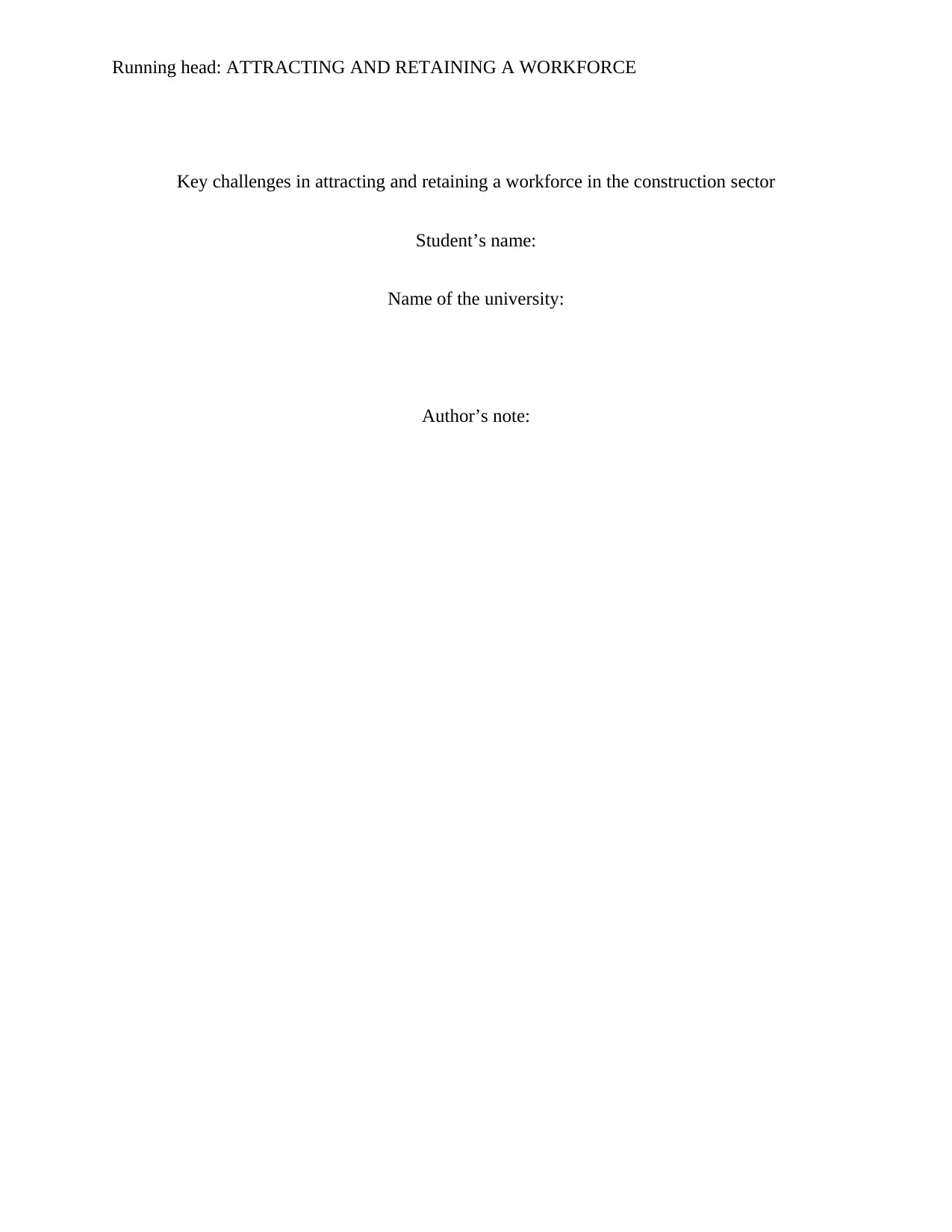
Running head: ATTRACTING AND RETAINING A WORKFORCE
Key challenges in attracting and retaining a workforce in the construction sector
Student’s name:
Name of the university:
Author’s note:
Key challenges in attracting and retaining a workforce in the construction sector
Student’s name:
Name of the university:
Author’s note:
Paraphrase This Document
Need a fresh take? Get an instant paraphrase of this document with our AI Paraphraser
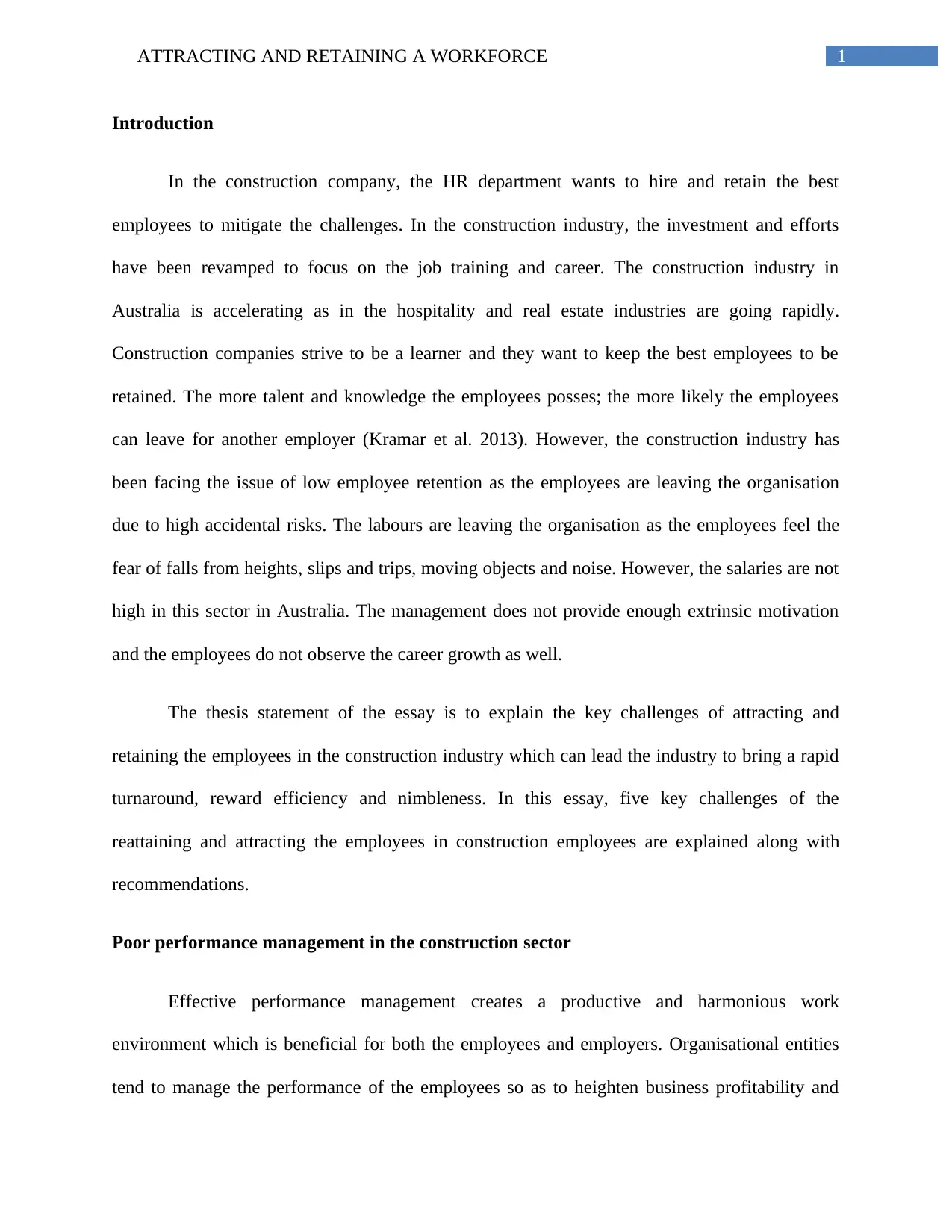
1ATTRACTING AND RETAINING A WORKFORCE
Introduction
In the construction company, the HR department wants to hire and retain the best
employees to mitigate the challenges. In the construction industry, the investment and efforts
have been revamped to focus on the job training and career. The construction industry in
Australia is accelerating as in the hospitality and real estate industries are going rapidly.
Construction companies strive to be a learner and they want to keep the best employees to be
retained. The more talent and knowledge the employees posses; the more likely the employees
can leave for another employer (Kramar et al. 2013). However, the construction industry has
been facing the issue of low employee retention as the employees are leaving the organisation
due to high accidental risks. The labours are leaving the organisation as the employees feel the
fear of falls from heights, slips and trips, moving objects and noise. However, the salaries are not
high in this sector in Australia. The management does not provide enough extrinsic motivation
and the employees do not observe the career growth as well.
The thesis statement of the essay is to explain the key challenges of attracting and
retaining the employees in the construction industry which can lead the industry to bring a rapid
turnaround, reward efficiency and nimbleness. In this essay, five key challenges of the
reattaining and attracting the employees in construction employees are explained along with
recommendations.
Poor performance management in the construction sector
Effective performance management creates a productive and harmonious work
environment which is beneficial for both the employees and employers. Organisational entities
tend to manage the performance of the employees so as to heighten business profitability and
Introduction
In the construction company, the HR department wants to hire and retain the best
employees to mitigate the challenges. In the construction industry, the investment and efforts
have been revamped to focus on the job training and career. The construction industry in
Australia is accelerating as in the hospitality and real estate industries are going rapidly.
Construction companies strive to be a learner and they want to keep the best employees to be
retained. The more talent and knowledge the employees posses; the more likely the employees
can leave for another employer (Kramar et al. 2013). However, the construction industry has
been facing the issue of low employee retention as the employees are leaving the organisation
due to high accidental risks. The labours are leaving the organisation as the employees feel the
fear of falls from heights, slips and trips, moving objects and noise. However, the salaries are not
high in this sector in Australia. The management does not provide enough extrinsic motivation
and the employees do not observe the career growth as well.
The thesis statement of the essay is to explain the key challenges of attracting and
retaining the employees in the construction industry which can lead the industry to bring a rapid
turnaround, reward efficiency and nimbleness. In this essay, five key challenges of the
reattaining and attracting the employees in construction employees are explained along with
recommendations.
Poor performance management in the construction sector
Effective performance management creates a productive and harmonious work
environment which is beneficial for both the employees and employers. Organisational entities
tend to manage the performance of the employees so as to heighten business profitability and
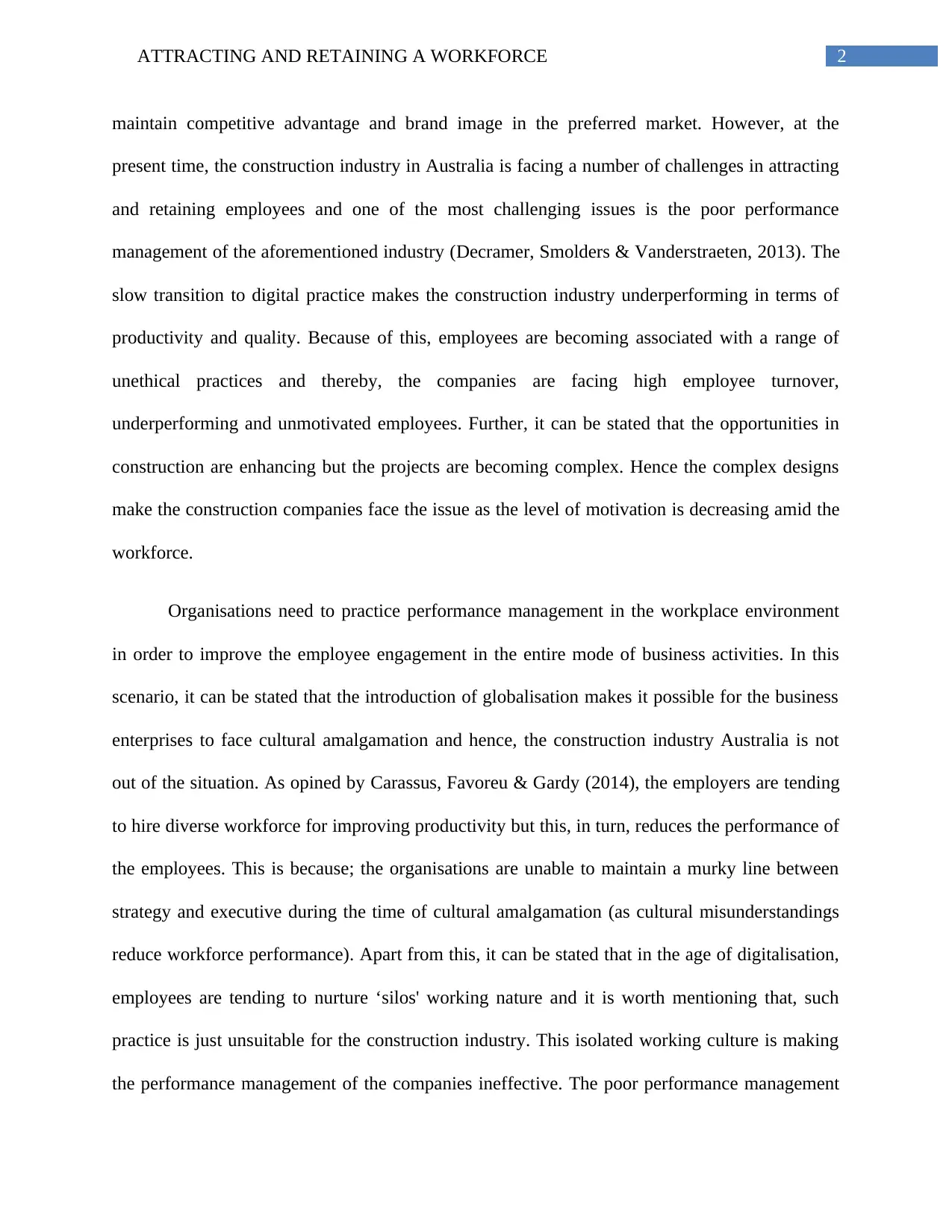
2ATTRACTING AND RETAINING A WORKFORCE
maintain competitive advantage and brand image in the preferred market. However, at the
present time, the construction industry in Australia is facing a number of challenges in attracting
and retaining employees and one of the most challenging issues is the poor performance
management of the aforementioned industry (Decramer, Smolders & Vanderstraeten, 2013). The
slow transition to digital practice makes the construction industry underperforming in terms of
productivity and quality. Because of this, employees are becoming associated with a range of
unethical practices and thereby, the companies are facing high employee turnover,
underperforming and unmotivated employees. Further, it can be stated that the opportunities in
construction are enhancing but the projects are becoming complex. Hence the complex designs
make the construction companies face the issue as the level of motivation is decreasing amid the
workforce.
Organisations need to practice performance management in the workplace environment
in order to improve the employee engagement in the entire mode of business activities. In this
scenario, it can be stated that the introduction of globalisation makes it possible for the business
enterprises to face cultural amalgamation and hence, the construction industry Australia is not
out of the situation. As opined by Carassus, Favoreu & Gardy (2014), the employers are tending
to hire diverse workforce for improving productivity but this, in turn, reduces the performance of
the employees. This is because; the organisations are unable to maintain a murky line between
strategy and executive during the time of cultural amalgamation (as cultural misunderstandings
reduce workforce performance). Apart from this, it can be stated that in the age of digitalisation,
employees are tending to nurture ‘silos' working nature and it is worth mentioning that, such
practice is just unsuitable for the construction industry. This isolated working culture is making
the performance management of the companies ineffective. The poor performance management
maintain competitive advantage and brand image in the preferred market. However, at the
present time, the construction industry in Australia is facing a number of challenges in attracting
and retaining employees and one of the most challenging issues is the poor performance
management of the aforementioned industry (Decramer, Smolders & Vanderstraeten, 2013). The
slow transition to digital practice makes the construction industry underperforming in terms of
productivity and quality. Because of this, employees are becoming associated with a range of
unethical practices and thereby, the companies are facing high employee turnover,
underperforming and unmotivated employees. Further, it can be stated that the opportunities in
construction are enhancing but the projects are becoming complex. Hence the complex designs
make the construction companies face the issue as the level of motivation is decreasing amid the
workforce.
Organisations need to practice performance management in the workplace environment
in order to improve the employee engagement in the entire mode of business activities. In this
scenario, it can be stated that the introduction of globalisation makes it possible for the business
enterprises to face cultural amalgamation and hence, the construction industry Australia is not
out of the situation. As opined by Carassus, Favoreu & Gardy (2014), the employers are tending
to hire diverse workforce for improving productivity but this, in turn, reduces the performance of
the employees. This is because; the organisations are unable to maintain a murky line between
strategy and executive during the time of cultural amalgamation (as cultural misunderstandings
reduce workforce performance). Apart from this, it can be stated that in the age of digitalisation,
employees are tending to nurture ‘silos' working nature and it is worth mentioning that, such
practice is just unsuitable for the construction industry. This isolated working culture is making
the performance management of the companies ineffective. The poor performance management
⊘ This is a preview!⊘
Do you want full access?
Subscribe today to unlock all pages.

Trusted by 1+ million students worldwide
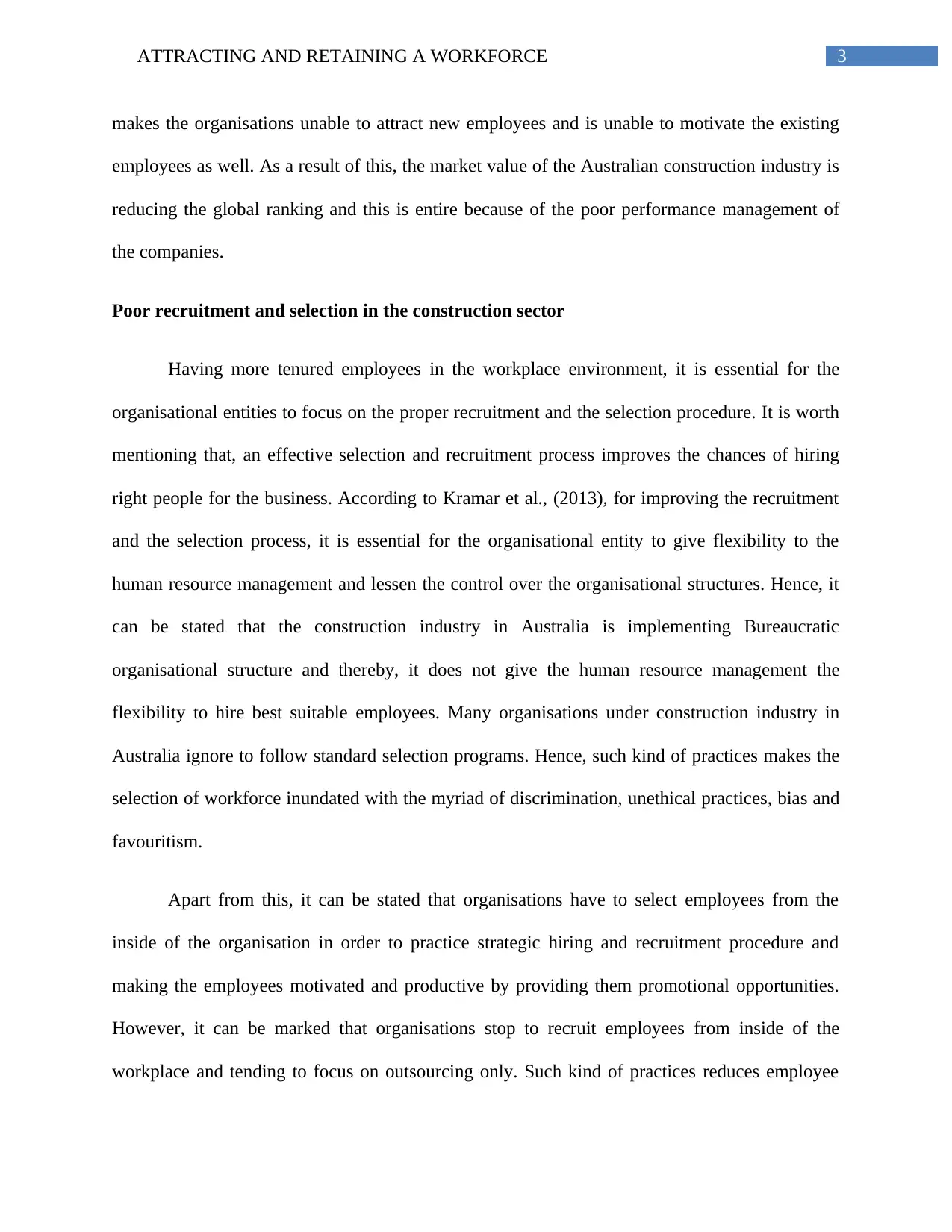
3ATTRACTING AND RETAINING A WORKFORCE
makes the organisations unable to attract new employees and is unable to motivate the existing
employees as well. As a result of this, the market value of the Australian construction industry is
reducing the global ranking and this is entire because of the poor performance management of
the companies.
Poor recruitment and selection in the construction sector
Having more tenured employees in the workplace environment, it is essential for the
organisational entities to focus on the proper recruitment and the selection procedure. It is worth
mentioning that, an effective selection and recruitment process improves the chances of hiring
right people for the business. According to Kramar et al., (2013), for improving the recruitment
and the selection process, it is essential for the organisational entity to give flexibility to the
human resource management and lessen the control over the organisational structures. Hence, it
can be stated that the construction industry in Australia is implementing Bureaucratic
organisational structure and thereby, it does not give the human resource management the
flexibility to hire best suitable employees. Many organisations under construction industry in
Australia ignore to follow standard selection programs. Hence, such kind of practices makes the
selection of workforce inundated with the myriad of discrimination, unethical practices, bias and
favouritism.
Apart from this, it can be stated that organisations have to select employees from the
inside of the organisation in order to practice strategic hiring and recruitment procedure and
making the employees motivated and productive by providing them promotional opportunities.
However, it can be marked that organisations stop to recruit employees from inside of the
workplace and tending to focus on outsourcing only. Such kind of practices reduces employee
makes the organisations unable to attract new employees and is unable to motivate the existing
employees as well. As a result of this, the market value of the Australian construction industry is
reducing the global ranking and this is entire because of the poor performance management of
the companies.
Poor recruitment and selection in the construction sector
Having more tenured employees in the workplace environment, it is essential for the
organisational entities to focus on the proper recruitment and the selection procedure. It is worth
mentioning that, an effective selection and recruitment process improves the chances of hiring
right people for the business. According to Kramar et al., (2013), for improving the recruitment
and the selection process, it is essential for the organisational entity to give flexibility to the
human resource management and lessen the control over the organisational structures. Hence, it
can be stated that the construction industry in Australia is implementing Bureaucratic
organisational structure and thereby, it does not give the human resource management the
flexibility to hire best suitable employees. Many organisations under construction industry in
Australia ignore to follow standard selection programs. Hence, such kind of practices makes the
selection of workforce inundated with the myriad of discrimination, unethical practices, bias and
favouritism.
Apart from this, it can be stated that organisations have to select employees from the
inside of the organisation in order to practice strategic hiring and recruitment procedure and
making the employees motivated and productive by providing them promotional opportunities.
However, it can be marked that organisations stop to recruit employees from inside of the
workplace and tending to focus on outsourcing only. Such kind of practices reduces employee
Paraphrase This Document
Need a fresh take? Get an instant paraphrase of this document with our AI Paraphraser
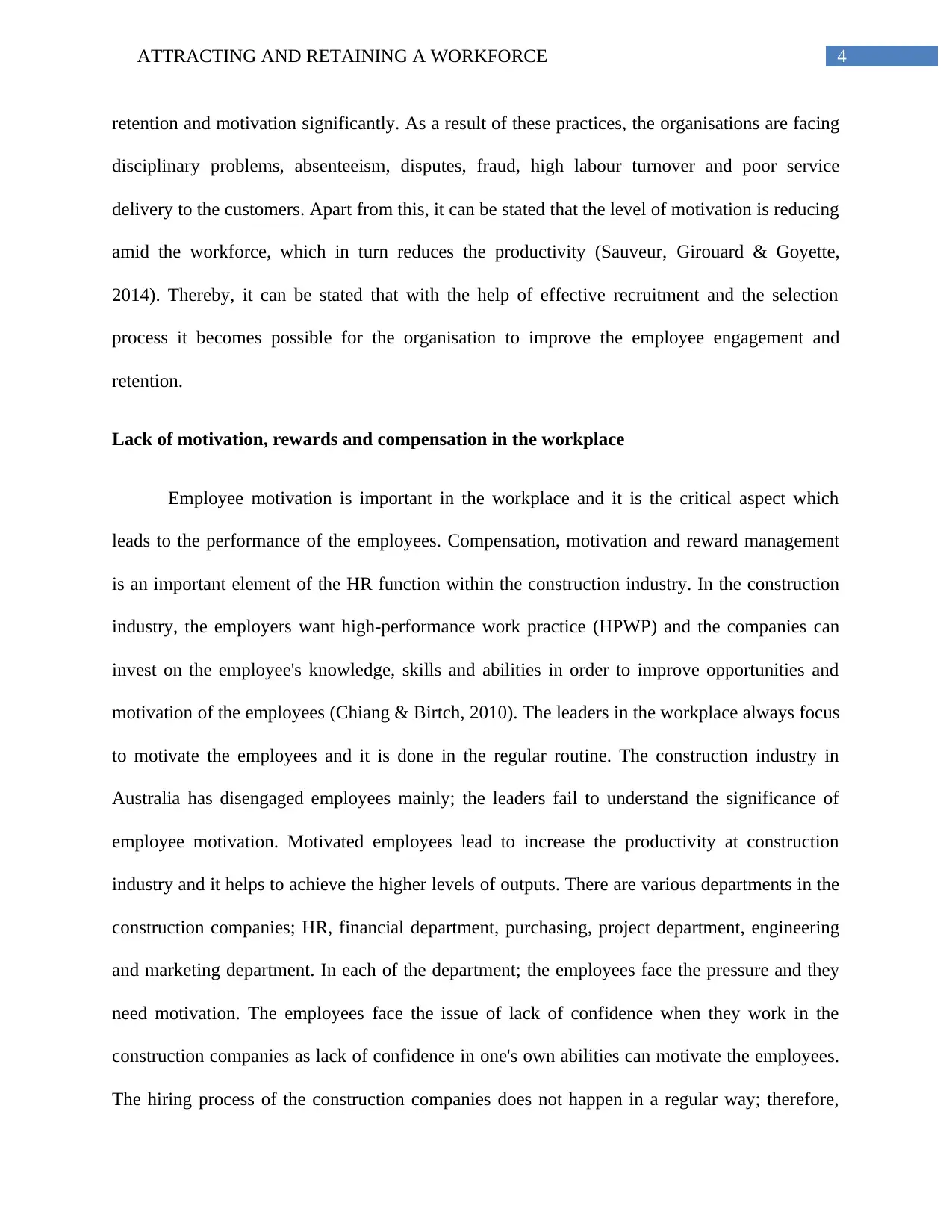
4ATTRACTING AND RETAINING A WORKFORCE
retention and motivation significantly. As a result of these practices, the organisations are facing
disciplinary problems, absenteeism, disputes, fraud, high labour turnover and poor service
delivery to the customers. Apart from this, it can be stated that the level of motivation is reducing
amid the workforce, which in turn reduces the productivity (Sauveur, Girouard & Goyette,
2014). Thereby, it can be stated that with the help of effective recruitment and the selection
process it becomes possible for the organisation to improve the employee engagement and
retention.
Lack of motivation, rewards and compensation in the workplace
Employee motivation is important in the workplace and it is the critical aspect which
leads to the performance of the employees. Compensation, motivation and reward management
is an important element of the HR function within the construction industry. In the construction
industry, the employers want high-performance work practice (HPWP) and the companies can
invest on the employee's knowledge, skills and abilities in order to improve opportunities and
motivation of the employees (Chiang & Birtch, 2010). The leaders in the workplace always focus
to motivate the employees and it is done in the regular routine. The construction industry in
Australia has disengaged employees mainly; the leaders fail to understand the significance of
employee motivation. Motivated employees lead to increase the productivity at construction
industry and it helps to achieve the higher levels of outputs. There are various departments in the
construction companies; HR, financial department, purchasing, project department, engineering
and marketing department. In each of the department; the employees face the pressure and they
need motivation. The employees face the issue of lack of confidence when they work in the
construction companies as lack of confidence in one's own abilities can motivate the employees.
The hiring process of the construction companies does not happen in a regular way; therefore,
retention and motivation significantly. As a result of these practices, the organisations are facing
disciplinary problems, absenteeism, disputes, fraud, high labour turnover and poor service
delivery to the customers. Apart from this, it can be stated that the level of motivation is reducing
amid the workforce, which in turn reduces the productivity (Sauveur, Girouard & Goyette,
2014). Thereby, it can be stated that with the help of effective recruitment and the selection
process it becomes possible for the organisation to improve the employee engagement and
retention.
Lack of motivation, rewards and compensation in the workplace
Employee motivation is important in the workplace and it is the critical aspect which
leads to the performance of the employees. Compensation, motivation and reward management
is an important element of the HR function within the construction industry. In the construction
industry, the employers want high-performance work practice (HPWP) and the companies can
invest on the employee's knowledge, skills and abilities in order to improve opportunities and
motivation of the employees (Chiang & Birtch, 2010). The leaders in the workplace always focus
to motivate the employees and it is done in the regular routine. The construction industry in
Australia has disengaged employees mainly; the leaders fail to understand the significance of
employee motivation. Motivated employees lead to increase the productivity at construction
industry and it helps to achieve the higher levels of outputs. There are various departments in the
construction companies; HR, financial department, purchasing, project department, engineering
and marketing department. In each of the department; the employees face the pressure and they
need motivation. The employees face the issue of lack of confidence when they work in the
construction companies as lack of confidence in one's own abilities can motivate the employees.
The hiring process of the construction companies does not happen in a regular way; therefore,
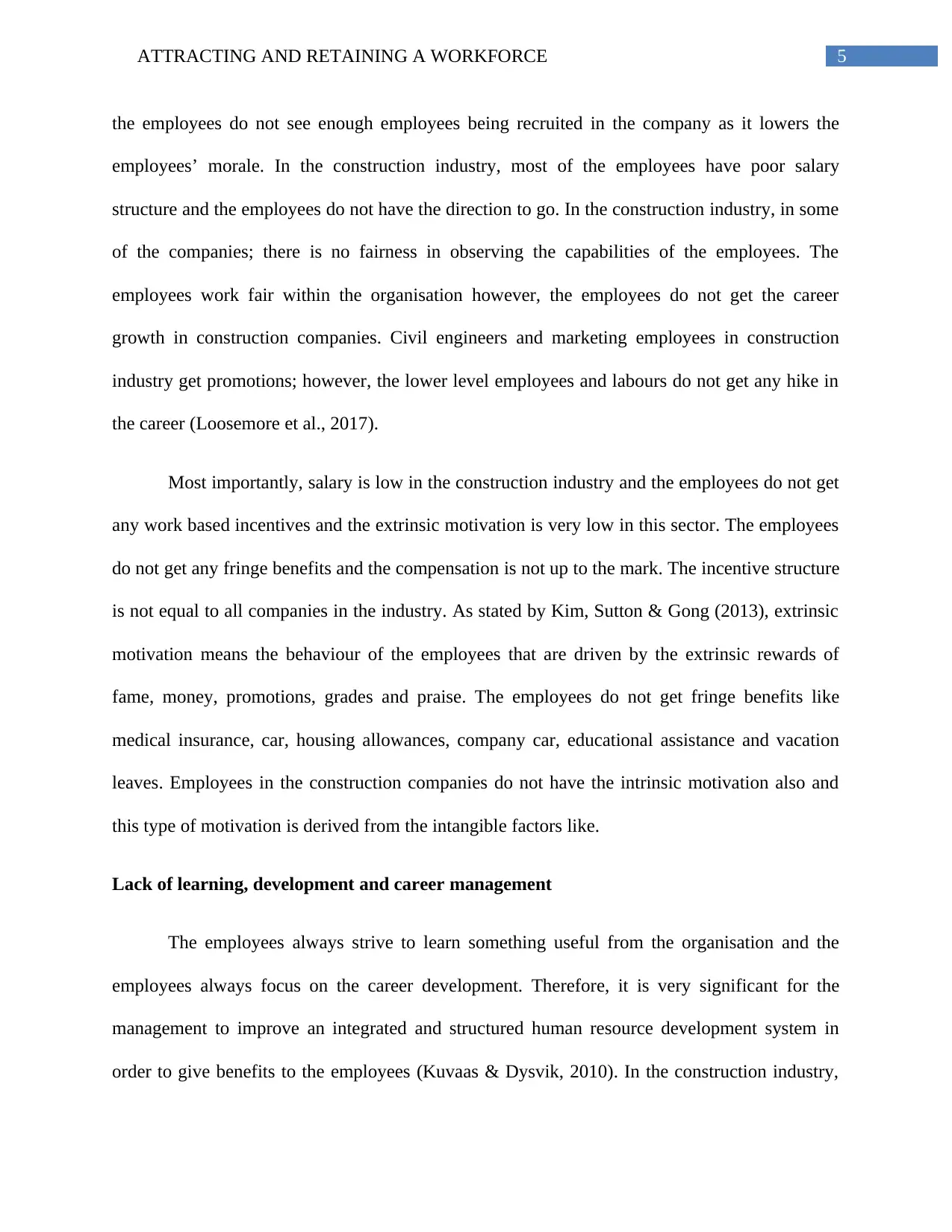
5ATTRACTING AND RETAINING A WORKFORCE
the employees do not see enough employees being recruited in the company as it lowers the
employees’ morale. In the construction industry, most of the employees have poor salary
structure and the employees do not have the direction to go. In the construction industry, in some
of the companies; there is no fairness in observing the capabilities of the employees. The
employees work fair within the organisation however, the employees do not get the career
growth in construction companies. Civil engineers and marketing employees in construction
industry get promotions; however, the lower level employees and labours do not get any hike in
the career (Loosemore et al., 2017).
Most importantly, salary is low in the construction industry and the employees do not get
any work based incentives and the extrinsic motivation is very low in this sector. The employees
do not get any fringe benefits and the compensation is not up to the mark. The incentive structure
is not equal to all companies in the industry. As stated by Kim, Sutton & Gong (2013), extrinsic
motivation means the behaviour of the employees that are driven by the extrinsic rewards of
fame, money, promotions, grades and praise. The employees do not get fringe benefits like
medical insurance, car, housing allowances, company car, educational assistance and vacation
leaves. Employees in the construction companies do not have the intrinsic motivation also and
this type of motivation is derived from the intangible factors like.
Lack of learning, development and career management
The employees always strive to learn something useful from the organisation and the
employees always focus on the career development. Therefore, it is very significant for the
management to improve an integrated and structured human resource development system in
order to give benefits to the employees (Kuvaas & Dysvik, 2010). In the construction industry,
the employees do not see enough employees being recruited in the company as it lowers the
employees’ morale. In the construction industry, most of the employees have poor salary
structure and the employees do not have the direction to go. In the construction industry, in some
of the companies; there is no fairness in observing the capabilities of the employees. The
employees work fair within the organisation however, the employees do not get the career
growth in construction companies. Civil engineers and marketing employees in construction
industry get promotions; however, the lower level employees and labours do not get any hike in
the career (Loosemore et al., 2017).
Most importantly, salary is low in the construction industry and the employees do not get
any work based incentives and the extrinsic motivation is very low in this sector. The employees
do not get any fringe benefits and the compensation is not up to the mark. The incentive structure
is not equal to all companies in the industry. As stated by Kim, Sutton & Gong (2013), extrinsic
motivation means the behaviour of the employees that are driven by the extrinsic rewards of
fame, money, promotions, grades and praise. The employees do not get fringe benefits like
medical insurance, car, housing allowances, company car, educational assistance and vacation
leaves. Employees in the construction companies do not have the intrinsic motivation also and
this type of motivation is derived from the intangible factors like.
Lack of learning, development and career management
The employees always strive to learn something useful from the organisation and the
employees always focus on the career development. Therefore, it is very significant for the
management to improve an integrated and structured human resource development system in
order to give benefits to the employees (Kuvaas & Dysvik, 2010). In the construction industry,
⊘ This is a preview!⊘
Do you want full access?
Subscribe today to unlock all pages.

Trusted by 1+ million students worldwide
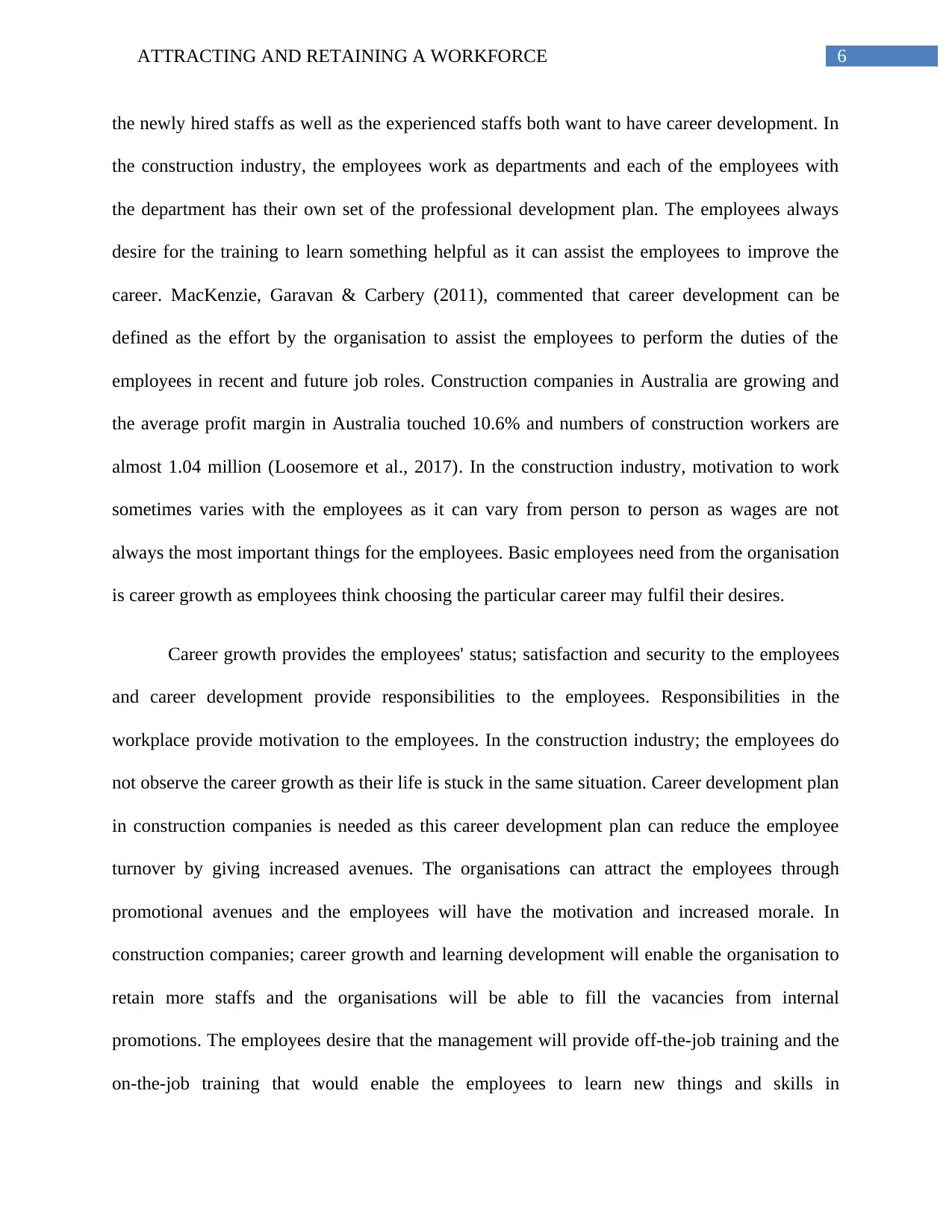
6ATTRACTING AND RETAINING A WORKFORCE
the newly hired staffs as well as the experienced staffs both want to have career development. In
the construction industry, the employees work as departments and each of the employees with
the department has their own set of the professional development plan. The employees always
desire for the training to learn something helpful as it can assist the employees to improve the
career. MacKenzie, Garavan & Carbery (2011), commented that career development can be
defined as the effort by the organisation to assist the employees to perform the duties of the
employees in recent and future job roles. Construction companies in Australia are growing and
the average profit margin in Australia touched 10.6% and numbers of construction workers are
almost 1.04 million (Loosemore et al., 2017). In the construction industry, motivation to work
sometimes varies with the employees as it can vary from person to person as wages are not
always the most important things for the employees. Basic employees need from the organisation
is career growth as employees think choosing the particular career may fulfil their desires.
Career growth provides the employees' status; satisfaction and security to the employees
and career development provide responsibilities to the employees. Responsibilities in the
workplace provide motivation to the employees. In the construction industry; the employees do
not observe the career growth as their life is stuck in the same situation. Career development plan
in construction companies is needed as this career development plan can reduce the employee
turnover by giving increased avenues. The organisations can attract the employees through
promotional avenues and the employees will have the motivation and increased morale. In
construction companies; career growth and learning development will enable the organisation to
retain more staffs and the organisations will be able to fill the vacancies from internal
promotions. The employees desire that the management will provide off-the-job training and the
on-the-job training that would enable the employees to learn new things and skills in
the newly hired staffs as well as the experienced staffs both want to have career development. In
the construction industry, the employees work as departments and each of the employees with
the department has their own set of the professional development plan. The employees always
desire for the training to learn something helpful as it can assist the employees to improve the
career. MacKenzie, Garavan & Carbery (2011), commented that career development can be
defined as the effort by the organisation to assist the employees to perform the duties of the
employees in recent and future job roles. Construction companies in Australia are growing and
the average profit margin in Australia touched 10.6% and numbers of construction workers are
almost 1.04 million (Loosemore et al., 2017). In the construction industry, motivation to work
sometimes varies with the employees as it can vary from person to person as wages are not
always the most important things for the employees. Basic employees need from the organisation
is career growth as employees think choosing the particular career may fulfil their desires.
Career growth provides the employees' status; satisfaction and security to the employees
and career development provide responsibilities to the employees. Responsibilities in the
workplace provide motivation to the employees. In the construction industry; the employees do
not observe the career growth as their life is stuck in the same situation. Career development plan
in construction companies is needed as this career development plan can reduce the employee
turnover by giving increased avenues. The organisations can attract the employees through
promotional avenues and the employees will have the motivation and increased morale. In
construction companies; career growth and learning development will enable the organisation to
retain more staffs and the organisations will be able to fill the vacancies from internal
promotions. The employees desire that the management will provide off-the-job training and the
on-the-job training that would enable the employees to learn new things and skills in
Paraphrase This Document
Need a fresh take? Get an instant paraphrase of this document with our AI Paraphraser
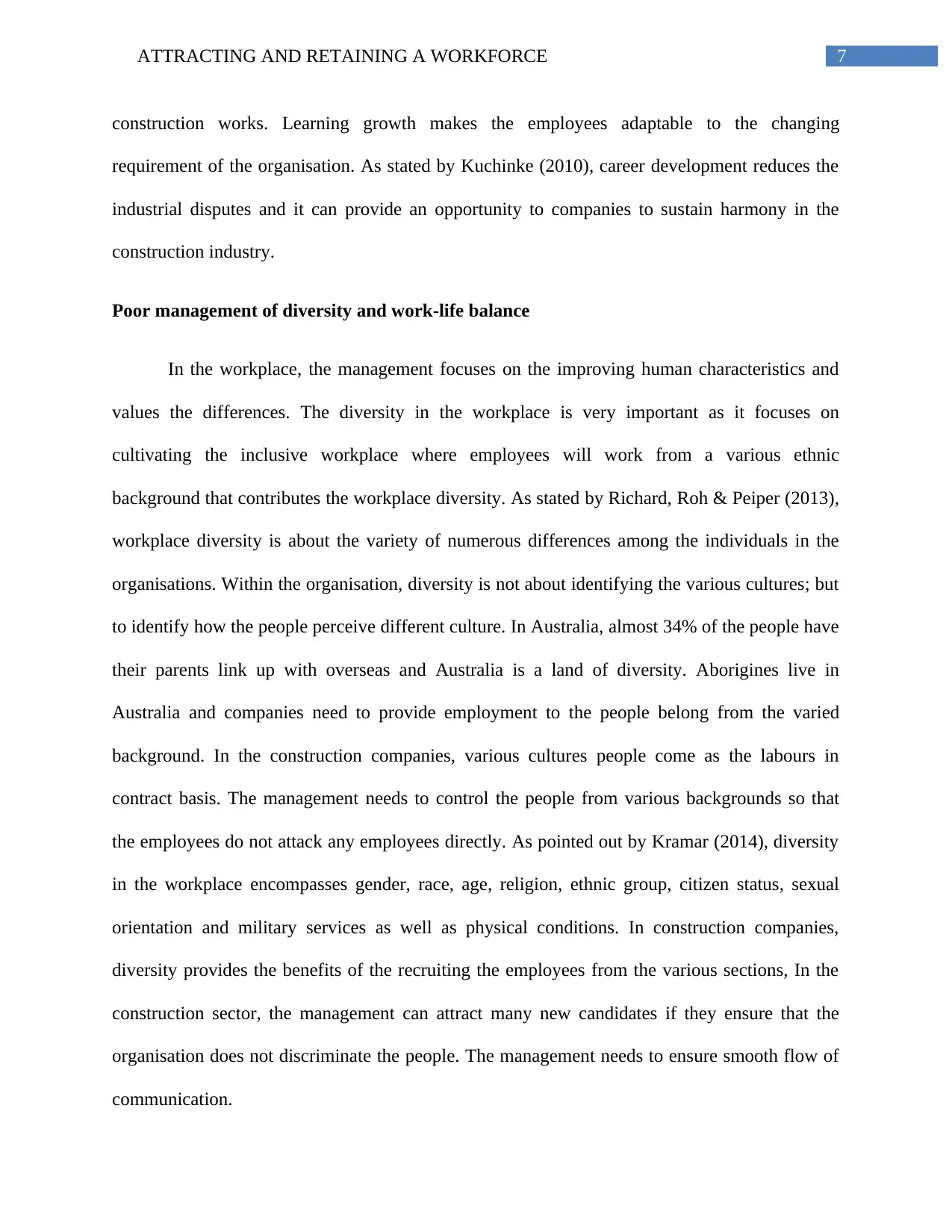
7ATTRACTING AND RETAINING A WORKFORCE
construction works. Learning growth makes the employees adaptable to the changing
requirement of the organisation. As stated by Kuchinke (2010), career development reduces the
industrial disputes and it can provide an opportunity to companies to sustain harmony in the
construction industry.
Poor management of diversity and work-life balance
In the workplace, the management focuses on the improving human characteristics and
values the differences. The diversity in the workplace is very important as it focuses on
cultivating the inclusive workplace where employees will work from a various ethnic
background that contributes the workplace diversity. As stated by Richard, Roh & Peiper (2013),
workplace diversity is about the variety of numerous differences among the individuals in the
organisations. Within the organisation, diversity is not about identifying the various cultures; but
to identify how the people perceive different culture. In Australia, almost 34% of the people have
their parents link up with overseas and Australia is a land of diversity. Aborigines live in
Australia and companies need to provide employment to the people belong from the varied
background. In the construction companies, various cultures people come as the labours in
contract basis. The management needs to control the people from various backgrounds so that
the employees do not attack any employees directly. As pointed out by Kramar (2014), diversity
in the workplace encompasses gender, race, age, religion, ethnic group, citizen status, sexual
orientation and military services as well as physical conditions. In construction companies,
diversity provides the benefits of the recruiting the employees from the various sections, In the
construction sector, the management can attract many new candidates if they ensure that the
organisation does not discriminate the people. The management needs to ensure smooth flow of
communication.
construction works. Learning growth makes the employees adaptable to the changing
requirement of the organisation. As stated by Kuchinke (2010), career development reduces the
industrial disputes and it can provide an opportunity to companies to sustain harmony in the
construction industry.
Poor management of diversity and work-life balance
In the workplace, the management focuses on the improving human characteristics and
values the differences. The diversity in the workplace is very important as it focuses on
cultivating the inclusive workplace where employees will work from a various ethnic
background that contributes the workplace diversity. As stated by Richard, Roh & Peiper (2013),
workplace diversity is about the variety of numerous differences among the individuals in the
organisations. Within the organisation, diversity is not about identifying the various cultures; but
to identify how the people perceive different culture. In Australia, almost 34% of the people have
their parents link up with overseas and Australia is a land of diversity. Aborigines live in
Australia and companies need to provide employment to the people belong from the varied
background. In the construction companies, various cultures people come as the labours in
contract basis. The management needs to control the people from various backgrounds so that
the employees do not attack any employees directly. As pointed out by Kramar (2014), diversity
in the workplace encompasses gender, race, age, religion, ethnic group, citizen status, sexual
orientation and military services as well as physical conditions. In construction companies,
diversity provides the benefits of the recruiting the employees from the various sections, In the
construction sector, the management can attract many new candidates if they ensure that the
organisation does not discriminate the people. The management needs to ensure smooth flow of
communication.
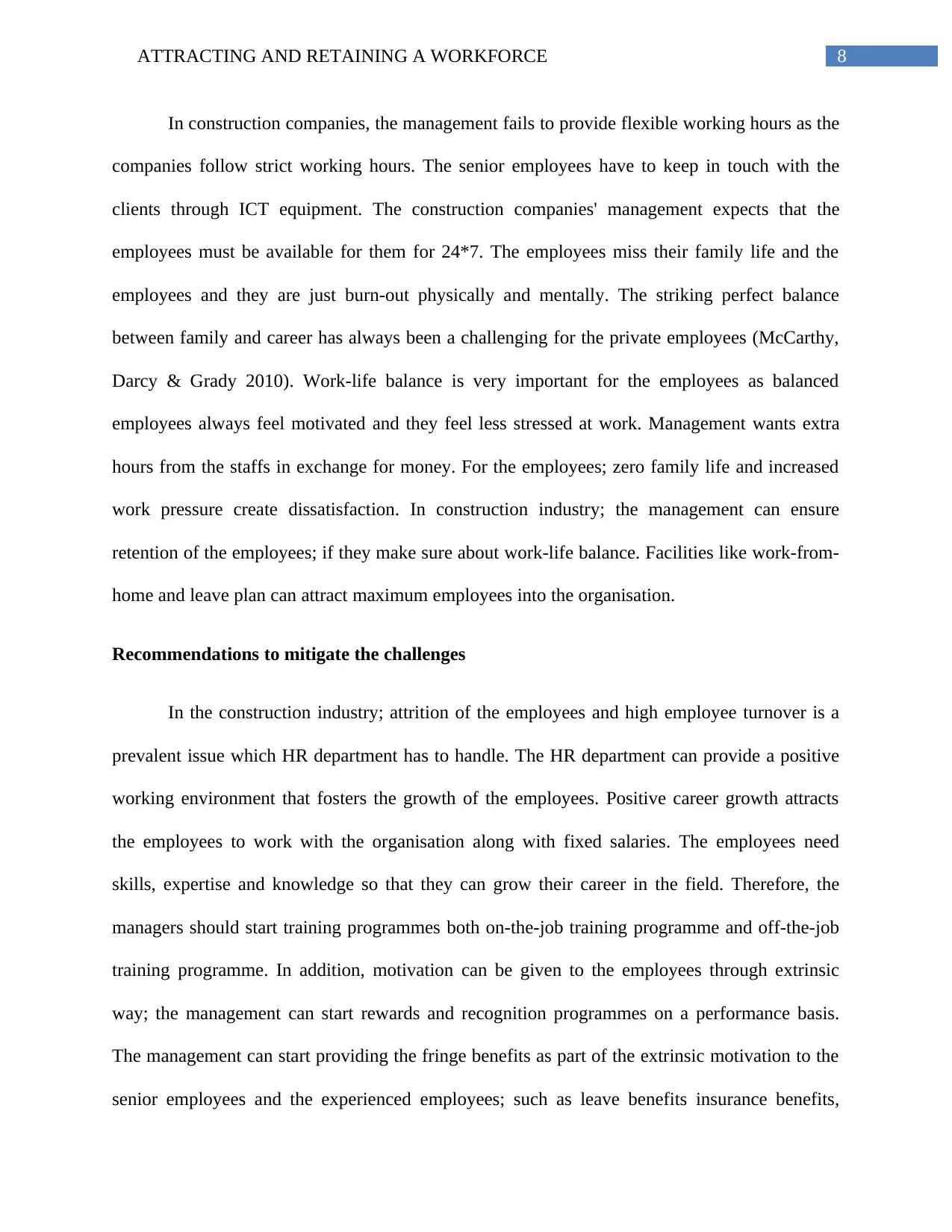
8ATTRACTING AND RETAINING A WORKFORCE
In construction companies, the management fails to provide flexible working hours as the
companies follow strict working hours. The senior employees have to keep in touch with the
clients through ICT equipment. The construction companies' management expects that the
employees must be available for them for 24*7. The employees miss their family life and the
employees and they are just burn-out physically and mentally. The striking perfect balance
between family and career has always been a challenging for the private employees (McCarthy,
Darcy & Grady 2010). Work-life balance is very important for the employees as balanced
employees always feel motivated and they feel less stressed at work. Management wants extra
hours from the staffs in exchange for money. For the employees; zero family life and increased
work pressure create dissatisfaction. In construction industry; the management can ensure
retention of the employees; if they make sure about work-life balance. Facilities like work-from-
home and leave plan can attract maximum employees into the organisation.
Recommendations to mitigate the challenges
In the construction industry; attrition of the employees and high employee turnover is a
prevalent issue which HR department has to handle. The HR department can provide a positive
working environment that fosters the growth of the employees. Positive career growth attracts
the employees to work with the organisation along with fixed salaries. The employees need
skills, expertise and knowledge so that they can grow their career in the field. Therefore, the
managers should start training programmes both on-the-job training programme and off-the-job
training programme. In addition, motivation can be given to the employees through extrinsic
way; the management can start rewards and recognition programmes on a performance basis.
The management can start providing the fringe benefits as part of the extrinsic motivation to the
senior employees and the experienced employees; such as leave benefits insurance benefits,
In construction companies, the management fails to provide flexible working hours as the
companies follow strict working hours. The senior employees have to keep in touch with the
clients through ICT equipment. The construction companies' management expects that the
employees must be available for them for 24*7. The employees miss their family life and the
employees and they are just burn-out physically and mentally. The striking perfect balance
between family and career has always been a challenging for the private employees (McCarthy,
Darcy & Grady 2010). Work-life balance is very important for the employees as balanced
employees always feel motivated and they feel less stressed at work. Management wants extra
hours from the staffs in exchange for money. For the employees; zero family life and increased
work pressure create dissatisfaction. In construction industry; the management can ensure
retention of the employees; if they make sure about work-life balance. Facilities like work-from-
home and leave plan can attract maximum employees into the organisation.
Recommendations to mitigate the challenges
In the construction industry; attrition of the employees and high employee turnover is a
prevalent issue which HR department has to handle. The HR department can provide a positive
working environment that fosters the growth of the employees. Positive career growth attracts
the employees to work with the organisation along with fixed salaries. The employees need
skills, expertise and knowledge so that they can grow their career in the field. Therefore, the
managers should start training programmes both on-the-job training programme and off-the-job
training programme. In addition, motivation can be given to the employees through extrinsic
way; the management can start rewards and recognition programmes on a performance basis.
The management can start providing the fringe benefits as part of the extrinsic motivation to the
senior employees and the experienced employees; such as leave benefits insurance benefits,
⊘ This is a preview!⊘
Do you want full access?
Subscribe today to unlock all pages.

Trusted by 1+ million students worldwide
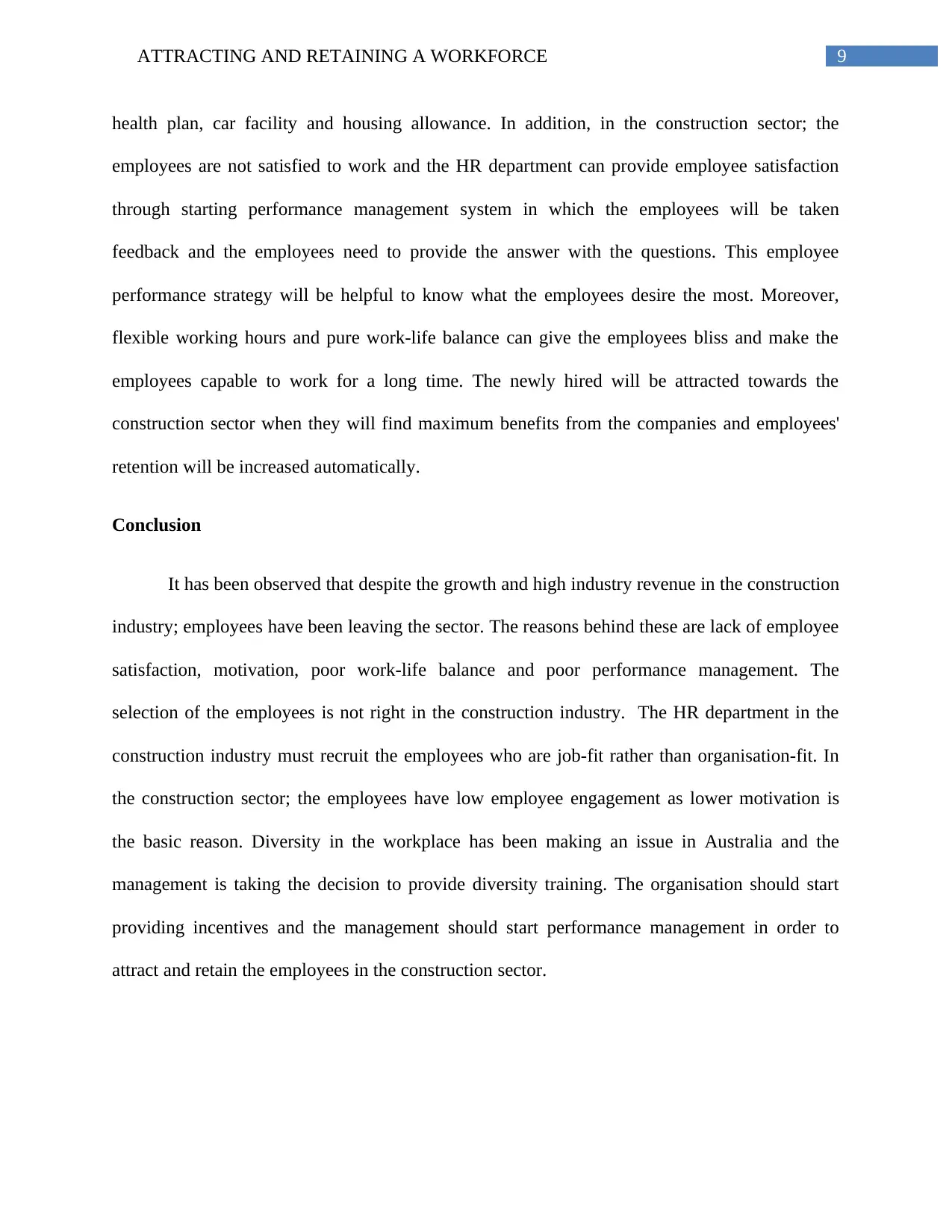
9ATTRACTING AND RETAINING A WORKFORCE
health plan, car facility and housing allowance. In addition, in the construction sector; the
employees are not satisfied to work and the HR department can provide employee satisfaction
through starting performance management system in which the employees will be taken
feedback and the employees need to provide the answer with the questions. This employee
performance strategy will be helpful to know what the employees desire the most. Moreover,
flexible working hours and pure work-life balance can give the employees bliss and make the
employees capable to work for a long time. The newly hired will be attracted towards the
construction sector when they will find maximum benefits from the companies and employees'
retention will be increased automatically.
Conclusion
It has been observed that despite the growth and high industry revenue in the construction
industry; employees have been leaving the sector. The reasons behind these are lack of employee
satisfaction, motivation, poor work-life balance and poor performance management. The
selection of the employees is not right in the construction industry. The HR department in the
construction industry must recruit the employees who are job-fit rather than organisation-fit. In
the construction sector; the employees have low employee engagement as lower motivation is
the basic reason. Diversity in the workplace has been making an issue in Australia and the
management is taking the decision to provide diversity training. The organisation should start
providing incentives and the management should start performance management in order to
attract and retain the employees in the construction sector.
health plan, car facility and housing allowance. In addition, in the construction sector; the
employees are not satisfied to work and the HR department can provide employee satisfaction
through starting performance management system in which the employees will be taken
feedback and the employees need to provide the answer with the questions. This employee
performance strategy will be helpful to know what the employees desire the most. Moreover,
flexible working hours and pure work-life balance can give the employees bliss and make the
employees capable to work for a long time. The newly hired will be attracted towards the
construction sector when they will find maximum benefits from the companies and employees'
retention will be increased automatically.
Conclusion
It has been observed that despite the growth and high industry revenue in the construction
industry; employees have been leaving the sector. The reasons behind these are lack of employee
satisfaction, motivation, poor work-life balance and poor performance management. The
selection of the employees is not right in the construction industry. The HR department in the
construction industry must recruit the employees who are job-fit rather than organisation-fit. In
the construction sector; the employees have low employee engagement as lower motivation is
the basic reason. Diversity in the workplace has been making an issue in Australia and the
management is taking the decision to provide diversity training. The organisation should start
providing incentives and the management should start performance management in order to
attract and retain the employees in the construction sector.
Paraphrase This Document
Need a fresh take? Get an instant paraphrase of this document with our AI Paraphraser

10ATTRACTING AND RETAINING A WORKFORCE
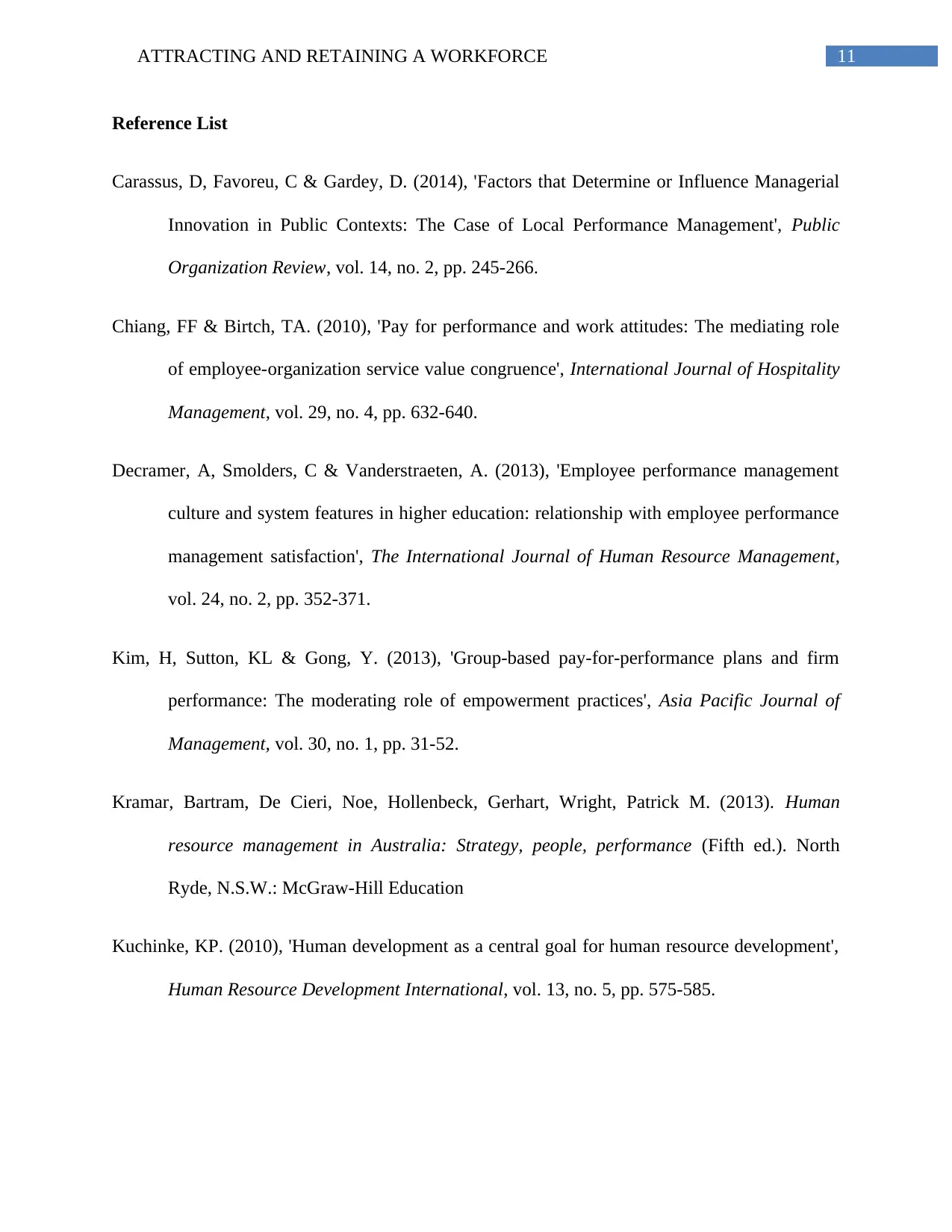
11ATTRACTING AND RETAINING A WORKFORCE
Reference List
Carassus, D, Favoreu, C & Gardey, D. (2014), 'Factors that Determine or Influence Managerial
Innovation in Public Contexts: The Case of Local Performance Management', Public
Organization Review, vol. 14, no. 2, pp. 245-266.
Chiang, FF & Birtch, TA. (2010), 'Pay for performance and work attitudes: The mediating role
of employee-organization service value congruence', International Journal of Hospitality
Management, vol. 29, no. 4, pp. 632-640.
Decramer, A, Smolders, C & Vanderstraeten, A. (2013), 'Employee performance management
culture and system features in higher education: relationship with employee performance
management satisfaction', The International Journal of Human Resource Management,
vol. 24, no. 2, pp. 352-371.
Kim, H, Sutton, KL & Gong, Y. (2013), 'Group-based pay-for-performance plans and firm
performance: The moderating role of empowerment practices', Asia Pacific Journal of
Management, vol. 30, no. 1, pp. 31-52.
Kramar, Bartram, De Cieri, Noe, Hollenbeck, Gerhart, Wright, Patrick M. (2013). Human
resource management in Australia: Strategy, people, performance (Fifth ed.). North
Ryde, N.S.W.: McGraw-Hill Education
Kuchinke, KP. (2010), 'Human development as a central goal for human resource development',
Human Resource Development International, vol. 13, no. 5, pp. 575-585.
Reference List
Carassus, D, Favoreu, C & Gardey, D. (2014), 'Factors that Determine or Influence Managerial
Innovation in Public Contexts: The Case of Local Performance Management', Public
Organization Review, vol. 14, no. 2, pp. 245-266.
Chiang, FF & Birtch, TA. (2010), 'Pay for performance and work attitudes: The mediating role
of employee-organization service value congruence', International Journal of Hospitality
Management, vol. 29, no. 4, pp. 632-640.
Decramer, A, Smolders, C & Vanderstraeten, A. (2013), 'Employee performance management
culture and system features in higher education: relationship with employee performance
management satisfaction', The International Journal of Human Resource Management,
vol. 24, no. 2, pp. 352-371.
Kim, H, Sutton, KL & Gong, Y. (2013), 'Group-based pay-for-performance plans and firm
performance: The moderating role of empowerment practices', Asia Pacific Journal of
Management, vol. 30, no. 1, pp. 31-52.
Kramar, Bartram, De Cieri, Noe, Hollenbeck, Gerhart, Wright, Patrick M. (2013). Human
resource management in Australia: Strategy, people, performance (Fifth ed.). North
Ryde, N.S.W.: McGraw-Hill Education
Kuchinke, KP. (2010), 'Human development as a central goal for human resource development',
Human Resource Development International, vol. 13, no. 5, pp. 575-585.
⊘ This is a preview!⊘
Do you want full access?
Subscribe today to unlock all pages.

Trusted by 1+ million students worldwide
1 out of 14
Related Documents
Your All-in-One AI-Powered Toolkit for Academic Success.
+13062052269
info@desklib.com
Available 24*7 on WhatsApp / Email
![[object Object]](/_next/static/media/star-bottom.7253800d.svg)
Unlock your academic potential
Copyright © 2020–2025 A2Z Services. All Rights Reserved. Developed and managed by ZUCOL.




